EarthBox growing offers a sustainable, innovative way to garden anywhere, providing an efficient system for water and fertilizer use. Perfect for beginners and experienced gardeners alike, it allows you to grow vegetables, herbs, and flowers with minimal effort and maximum yield. This foolproof method ensures healthy plant growth in any climate, making it a popular choice for urban and small-space gardening. The EarthBox system is designed to simplify gardening while promoting eco-friendly practices, making it accessible to everyone.
What is an EarthBox?
An EarthBox is a self-watering, sustainable container gardening system designed for growing vegetables, herbs, and flowers. It features a built-in water reservoir, aeration screen, and fertilizer strip to optimize plant growth. This innovative system reduces the need for frequent watering and fertilizing, making it ideal for gardeners of all skill levels. Its eco-friendly design promotes efficient resource use, ensuring healthy plant development in various environments.
Benefits of Using an EarthBox for Gardening
Using an EarthBox offers numerous benefits, including efficient water and fertilizer use, reduced labor, and consistent plant growth. Its self-watering design ensures plants receive the right amount of moisture, minimizing overwatering. The system is ideal for small spaces, urban gardening, and beginners. It promotes healthy root development, maximizes yields, and allows for year-round gardening in various climates. This eco-friendly method simplifies gardening while producing fresh, high-quality crops.
EarthBox Components and Setup
The EarthBox system includes a container, aeration screen, water reservoir, fertilizer strip, and potting soil. Setup involves assembling these components, filling the reservoir, and adding soil up to the recommended level.
Overview of the EarthBox System
The EarthBox system is a self-watering container gardening solution designed for optimal plant growth. It features a water reservoir, aeration screen, and fertilizer strip to ensure efficient water and nutrient delivery. This system minimizes water waste and reduces the need for frequent fertilization. It’s ideal for growing vegetables, herbs, and flowers in small spaces, making it perfect for urban gardeners and those new to gardening.
Key Components: Aeration Screen, Water Reservoir, and Fertilizer Strip
The EarthBox system includes three essential components: the aeration screen, water reservoir, and fertilizer strip. The aeration screen prevents waterlogging and promotes healthy root growth. The water reservoir stores water, releasing it as plants need it, while the fertilizer strip provides nutrients for optimal growth. These components work together to create a self-sustaining gardening solution.
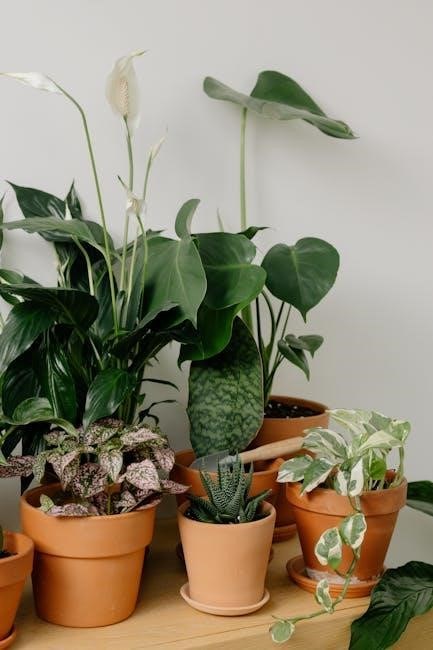
Choosing the Right Plants for Your EarthBox
The EarthBox supports a wide variety of plants, including vegetables, herbs, and flowers. Choose from popular options available at your local nursery for optimal growth.
Plant Selection: Vegetables, Herbs, and Flowers
EarthBox gardens thrive with a diverse range of plants. Vegetables like tomatoes, peppers, and cucumbers grow exceptionally well, while herbs such as basil and mint add fresh flavor. Flowers like marigolds and zinnias can also be included for color and pollination support. This versatility allows gardeners to create a balanced and productive growing space, ensuring a bountiful harvest throughout the season.
Spacing and Placement Guidelines for Optimal Growth
Proper spacing and placement are crucial for maximizing growth in an EarthBox. Refer to plant-specific charts for spacing recommendations, ensuring adequate room for root development and airflow. Larger plants like tomatoes should be placed toward the back, while smaller ones like herbs can be positioned near the front. Ensure all plants receive sufficient sunlight, typically 6 hours daily, and avoid overcrowding to prevent disease. Use the fertilizer strip as a guide for placement to optimize nutrient distribution and promote healthy growth.
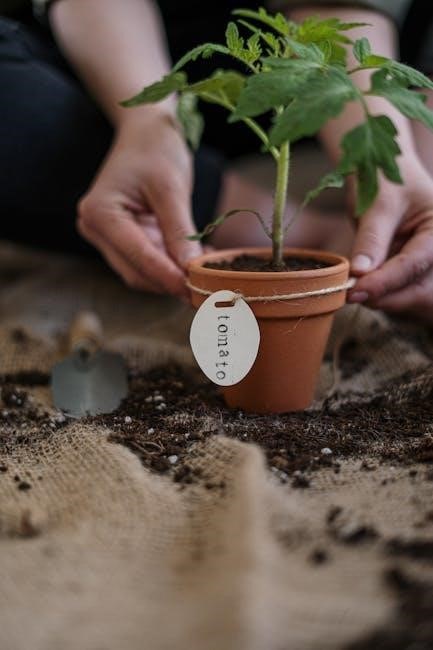
Planting Instructions
Assemble materials, place the tube, pack potting soil, and fill the water reservoir. Plant seeds or seedlings according to package instructions for optimal growth and yield.
Step-by-Step Guide to Assembling Your EarthBox
Begin by placing the aeration screen at the bottom of the EarthBox. Insert the water fill tube into the designated hole. Add a 2-inch layer of potting soil, ensuring it covers the screen. Fill the reservoir with water, then add the remaining soil, packing it firmly. Place the fertilizer strip in the center. Your EarthBox is now ready for planting seeds or seedlings following the provided instructions.
Planting Seeds or Seedlings: Best Practices
Start by placing seeds or seedlings in the center of the EarthBox, following the depth and spacing guidelines on the seed package. For seedlings, gently remove packaging and position them evenly. Cover with a thin layer of potting soil, ensuring proper spacing for growth. Water lightly after planting. Use the fertilizer strip as directed, avoiding additional fertilizers during the growing season for optimal results.
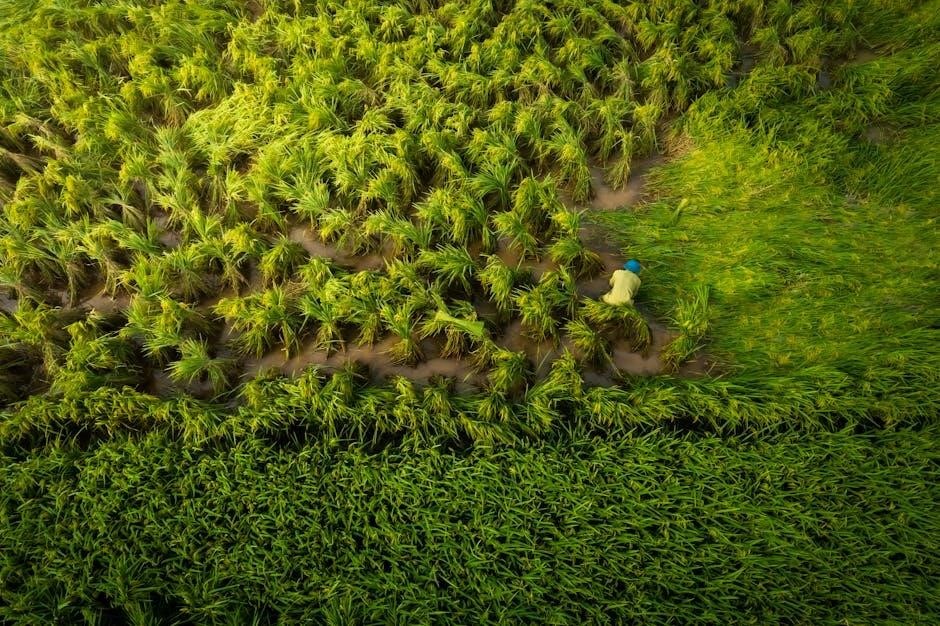
Fertilization and Soil Management
The EarthBox system includes a fertilizer strip for steady nutrient release. Add dolomite lime to prevent blossom end rot and ensure soil health. Avoid extra fertilizers during growth.
Using the Fertilizer Strip: Dos and Don’ts
Place the fertilizer strip in the center of the EarthBox, ensuring even nutrient distribution. Avoid adding extra fertilizers during the growing season. Use dolomite lime to prevent blossom end rot and maintain soil health. Follow the provided guidelines for optimal plant growth and nutrient balance. Proper placement ensures steady nutrient release, promoting healthy plant development without over-fertilizing.
Organic Fertilization Options for EarthBox Gardens
For an eco-friendly approach, use compost tea or nutrient-rich top dressings in your EarthBox. These methods enhance soil fertility naturally. Consider adding organic matter like worm castings or well-rotted manure to boost plant health. Balancing these options ensures robust growth without synthetic chemicals, aligning with sustainable gardening practices and promoting a thriving ecosystem for your plants.
Watering Your EarthBox
The EarthBox water reservoir system ensures consistent moisture, reducing the need for frequent watering. Fill the reservoir, and the aeration screen prevents waterlogging. Perfect for all climates, it promotes healthy root growth and minimizes water waste, making it ideal for efficient gardening. Regular checks ensure optimal hydration for your plants, regardless of weather conditions.
Understanding the Water Reservoir System
The EarthBox water reservoir system is designed to provide consistent moisture to plants. The reservoir holds water, which is distributed as plants need it through the aeration screen, preventing waterlogging. This efficient system reduces watering frequency and ensures roots receive oxygen and water. Perfect for all climates, it minimizes water waste while promoting healthy root growth and robust plant development.
- Water is stored in the reservoir below the soil.
- The aeration screen prevents water from flooding the soil.
- Plants draw water as needed, ensuring optimal hydration.
How Often to Water: Tips for Different Climates
Watering frequency depends on your climate. In hot climates, water every 2-3 days, while cooler climates may need watering once a week. Check soil moisture by inserting your finger into the potting mix. If dry, refill the reservoir. Ensure plants receive at least 6 hours of sunlight daily, with afternoon shade in extreme heat. Adjust based on weather conditions for optimal growth.
- Hot climates: Water every 2-3 days.
- Cooler climates: Water once a week.
- Check soil moisture before refilling.
- Provide morning sun for best results.
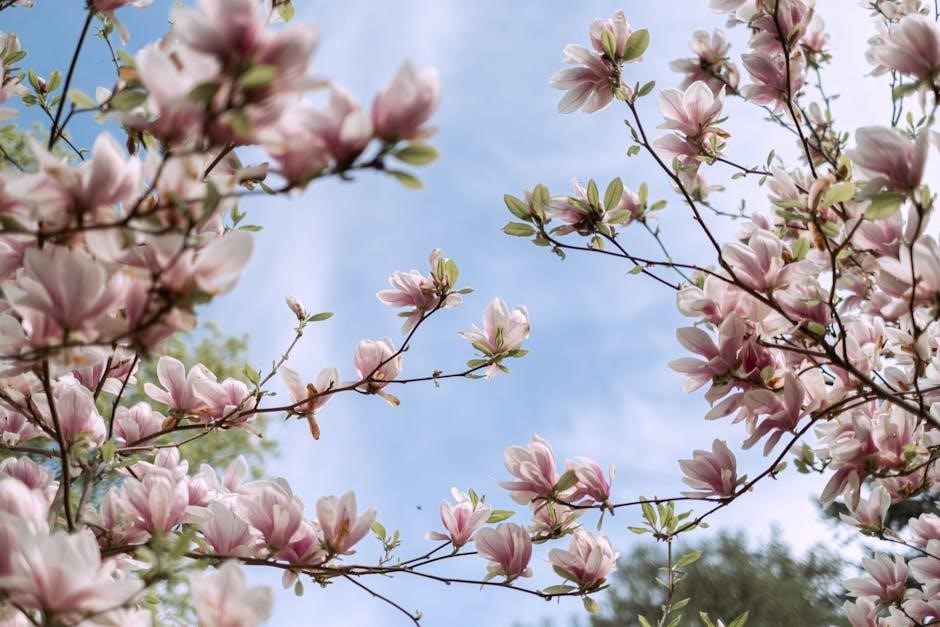
Pest and Disease Management
EarthBox gardens are susceptible to pests like aphids and spider mites. Regularly inspect plants and use organic pest control methods to prevent infestations. Treat with neem oil or insecticidal soap if necessary.
- Sanitize tools to avoid spreading disease.
- Ensure proper air circulation.
- Monitor plants daily for signs of trouble.
Common Pests in Container Gardens and How to Control Them
EarthBox gardens often face pests like aphids, spider mites, and whiteflies. Inspect plants regularly and treat infestations early. Use neem oil or insecticidal soap for control. Maintain cleanliness and ensure proper air circulation to prevent outbreaks. Avoid overwatering, which can attract pests. Introduce beneficial insects like ladybugs to naturally manage infestations. Regular monitoring is key to protecting your plants and ensuring a healthy harvest.
- Inspect plants daily for signs of pests.
- Use organic pest control methods first.
- Prevent infestations with good hygiene practices.
Disease Prevention: Signs to Watch For
Prevent diseases in your EarthBox by monitoring for yellowing leaves, black spots, or powdery mildew. Overwatering can lead to root rot, while under-watering may cause nutrient deficiencies. Ensure good air circulation and avoid splashing water on leaves. Use sterile potting soil and provide balanced nutrients to promote healthy plant growth. Act quickly at the first sign of disease to prevent its spread and protect your harvest.
- Watch for yellowing or distorted leaves.
- Inspect for black spots or powdery patches.
- Prevent overwatering to avoid root rot.

Pruning and Training Plants
Pruning and training plants in your EarthBox enhances growth and yield. Use techniques like trimming excess foliage and training vines with stakes or trellises for optimal results.
- Prune regularly to improve air circulation.
- Train tall plants to maximize vertical space.
Pruning Techniques for Maximum Yield
Pruning is a key technique to maximize your EarthBox harvest. Regular trimming removes dead or diseased leaves, promoting healthy growth and better fruit production. Prune plants early in the growing season to shape their structure and encourage bushy growth. For vining plants, trim back overgrown stems to redirect energy to productive areas. Use clean, sharp tools to prevent spreading diseases. This practice ensures your plants remain vigorous and productive throughout the season.
- Remove lower leaves to improve air circulation.
- Trim flower clusters for larger fruit development.
- Monitor plant response to adjust pruning frequency.
Training Vines and Tall Plants in an EarthBox
Training vines and tall plants in an EarthBox requires proper support to maximize space and promote healthy growth. Install a trellis or stake early to guide climbing plants like peas or tomatoes. Secure vines gently with soft ties to avoid damage. For tall plants, trim back overgrown stems and shape the plant to encourage bushy growth. This technique improves sunlight exposure and reduces overcrowding, ensuring better yields and blooms.
- Install trellises or stakes at planting time for climbing vines.
- Use soft ties to secure stems without causing damage.
- Prune lower leaves to enhance air circulation and light penetration.
- Trim flower clusters to encourage larger blooms or fruit development.
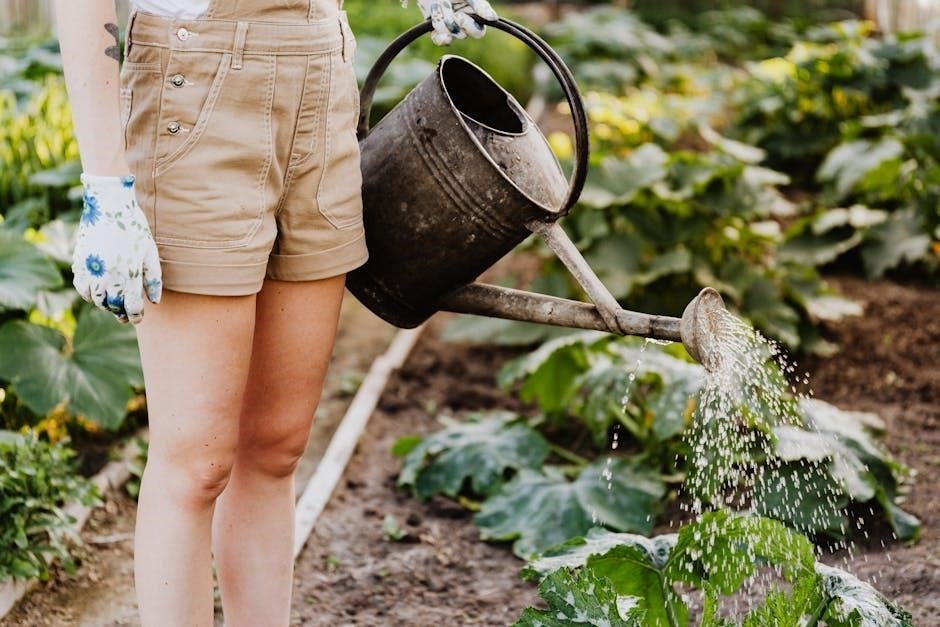
Seasonal Care and Maintenance
Adapt your EarthBox care throughout the year to ensure optimal growth. Protect plants from extreme temperatures and clean the system regularly to maintain efficiency and health.
- Adjust watering based on seasonal changes.
- Use shade cloth in hot climates during summer.
- Clean the reservoir and aeration screen periodically.
- Prepare the EarthBox for the next growing cycle.
Caring for Your EarthBox in Different Seasons
Adapt your EarthBox care to match seasonal changes for optimal plant health. In spring, prepare the system with fresh potting mix and fertilizer. Summer requires consistent watering and shade protection in hot climates. Fall involves cleaning the reservoir and aeration screen, while winter demands protection from frost to prevent damage. Regular maintenance ensures your EarthBox remains efficient and productive year-round.
Extending the Growing Season with Protection
Extend your growing season by shielding your EarthBox from extreme temperatures and frost. Use row covers or cold frames to protect plants during early frosts. In hot climates, employ shade cloth to prevent overheating. Proper protection allows continued growth and maximizes harvest, ensuring your plants thrive beyond the typical season; Regular monitoring ensures the best results for prolonged productivity and plant health.
Harvesting Your Crop
Harvest your EarthBox crops at peak ripeness for optimal flavor and texture. Use scissors for herbs and check vegetable sizes regularly. Store produce properly to maintain freshness and extend enjoyment.
When and How to Harvest for Optimal Flavor
Harvest crops when they reach peak ripeness for maximum flavor. Check vegetables daily, as overripe produce can spoil quickly. Use scissors for herbs and gentle twisting for root vegetables. For fruits like tomatoes, a slight softening indicates readiness. Store harvested produce in cool, dry places to maintain freshness and extend shelf life. Proper timing ensures the best taste and texture;
Storage Tips for Your Fresh Harvest
Store fresh produce in breathable containers or bags to maintain humidity and prevent spoilage. Keep fruits and vegetables separate, as some release ethylene, accelerating ripening. Refrigerate most crops at 32-40°F (0-4°C) to prolong freshness. For root vegetables, store in cool, dark places with good ventilation. Herbs can be dried or frozen for long-term preservation. Proper storage ensures your harvest stays fresh and nutritious for a longer period.
Troubleshooting Common Issues
Troubleshoot common issues like overwatering, pests, and nutrient deficiencies by checking water levels, inspecting plants regularly, and adjusting fertilizer use as needed for optimal growth.
Diagnosing and Solving Problems in Your EarthBox
Identify issues like waterlogged soil, pests, or nutrient deficiencies by observing plant health and system performance. Check the water reservoir levels, inspect for pests, and adjust fertilizer application. Ensure proper aeration and drainage to prevent root rot. For persistent problems, consult EarthBox guides or gardening experts for tailored solutions. Regular maintenance and monitoring are key to resolving issues promptly and ensuring optimal growth.
FAQs: Addressing Common Concerns
Frequently asked questions about EarthBox gardening include queries on water reservoir management, optimal plant selection, and troubleshooting common issues. Gardeners often inquire about the best fertilizers to use and how to prevent pests. Additionally, questions arise about extending the growing season and storage tips for harvested crops. These concerns are addressed in detailed guides and resources available for EarthBox users, ensuring successful gardening experiences.





